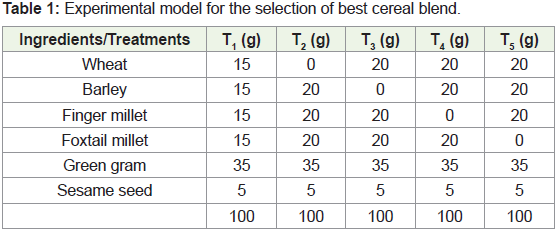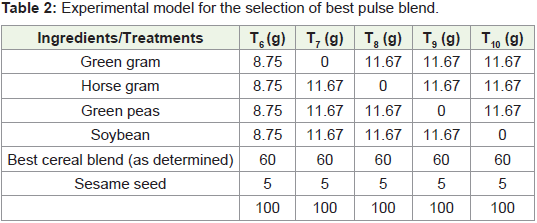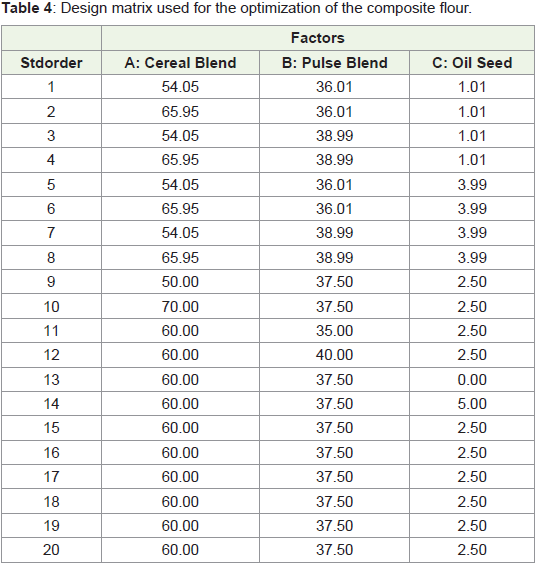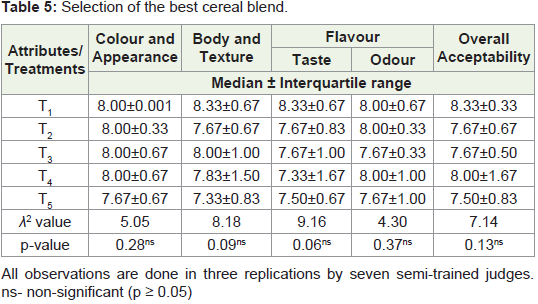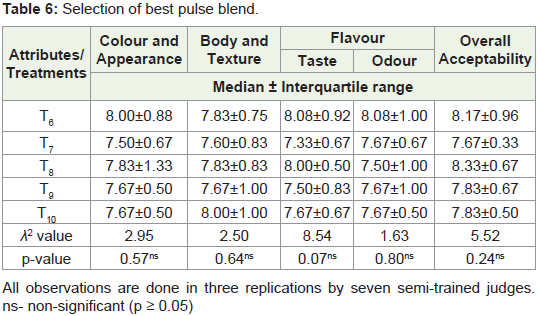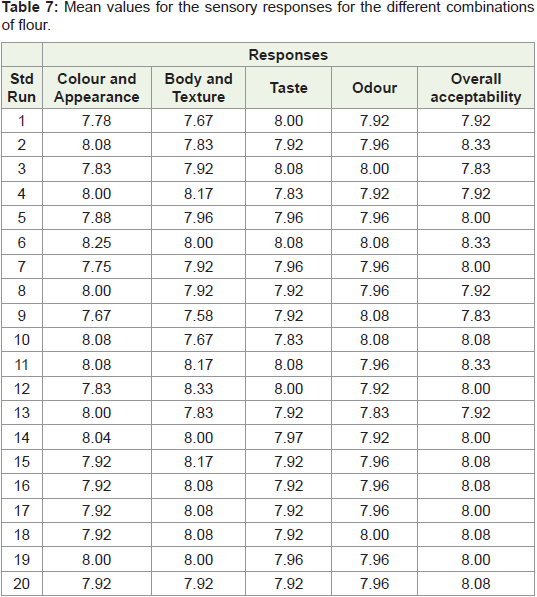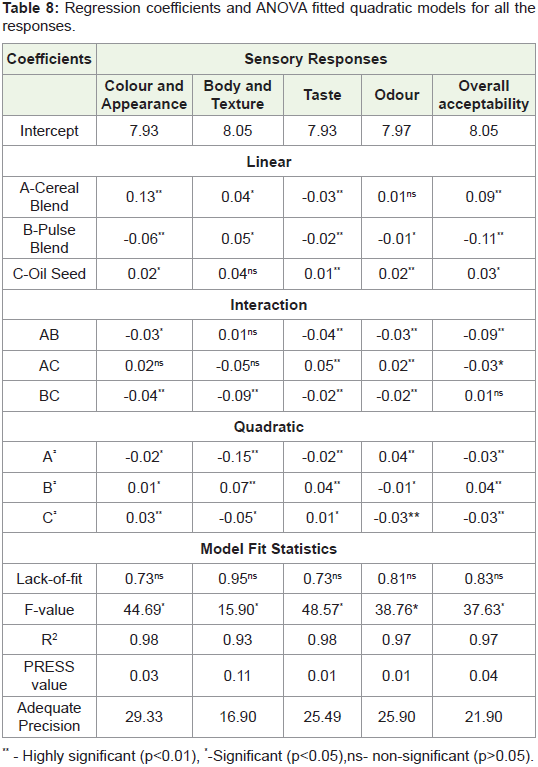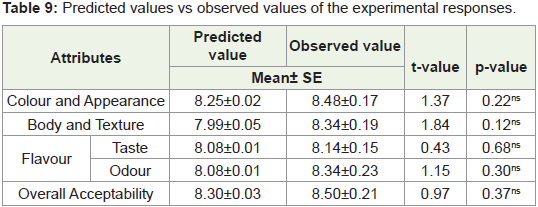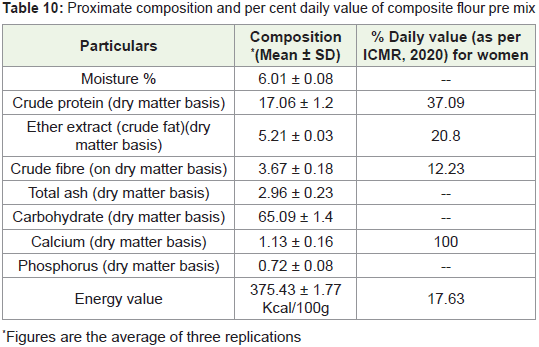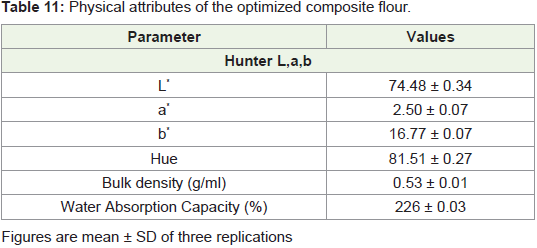Research Article
Development of High Protein Composite flour pre-mix for Women Using Response Surface Methodology
Beena RL1*, Rajakumar SN2, Sudheerbabu P2, Beena AK2, Divya MP2, Athira S2 and Purushothaman S3
1College of Dairy Science and Technology, Thiruvananthapuram- 695040, Kerala, India
2Verghese Kurien Institute of Dairy and Food Technology, Thrissur-680651, Kerala, India
3College of Veterinary and Animal Sciences, Thrissur-680651, Kerala, India
*Corresponding author: Beena RL, Department of Dairy Technology, College of Dairy Science and Technology,
Thiruvananthapuram- 695040, Kerala, India; E-mail: beenarl@kvasu.ac.in
Article Information: Submission: 01/03/2022; Accepted: 08/04/2022; Published: 11/04/2022
Copyright: © 2022 Beena RL, et al. This is an open access article distributed under the Creative Commons Attribution License, which
permits unrestricted use, distribution, and reproduction in any medium, provided the original work is properly cited.
Abstract
Background: India has a higher ratio of malnourished women in the world. Cereals and pulses are said to be the best combination for delivering good
nutrients, particularly in the dietary pattern of low economic populations.
Objectives: The present investigation is the development of a nutritious composite flour mix for women that can be cooked into a healthy porridge in water
or skimmed milk to meet her daily nutrient requirements as per the recommendation of the Indian Council of Medical Research (ICMR), 2020.
Methods: The tool used was the Central Composite Rotatable Design of Response Surface Methodology. Locally available and nutrient-rich cereals,
pulses and oilseed were selected based on preliminary trials. The sensory responses for color and appearance, body and texture, taste, odor and overall
acceptability were studied and statistical validation was done using SPSS 22 software.
Results: Maximum sensory scores were obtained for an ingredient composition of 65.95, 37.50 and 3.99 grams of cereal blend, pulse blend and
oilseed respectively. The proximate analysis of the optimized product gave 17.06%, 5.21%, 3.67%, 2.96%, 65.09%, and 1.13% of protein, fat, crude fiber,
ash, carbohydrate, and calcium. 100g of the optimized product could meet 17.63% of energy and 100% of the calcium requirements for women as per RDA
recommendation.
Keywords
Cereal and pulse blend; Composite flour; High protein pre-mix; Women health mix
Introduction
In India, the rate of malnutrition among adolescent girls,
pregnant and lactating women shows high trend as per UNICEF and
WHO [1]. The diet of Indian women does not meet their nutritional
requirements. Addressing women’s malnutrition brings forth healthy
women who play multiple roles in society which helps them raise the
socio-economic status of the country. The ICMR – National Institute
of Nutrition (NIN) Expert Group suggestion in 2020, on Nutrient
Requirement for Indians reported that women in moderate category
of work need 2130 kilocalories of energy per day, which includes 36g
protein and 25g visible fat. Females of age between 19 and 39 years are
grouped under the category “women” with an average body weight
of 55kg [2].
A survey conducted by the Associated Chamber of Commerce
and Industry in India reveals that 68% of working women are affected
with lifestyle ailments like obesity, chronic backache, diabetes,
hypertension and 75% of them suffer from depression or general
anxiety disorder [3]. A healthy diet and adequate physical activity can
mitigate the situation. Intake of dietary fiber can reduce the risk of
type II diabetes and cardiovascular disease and improves serum lipid
levels, and lowers blood pressure [4-7]. In vitro, animal and human
in vivo studies on the health benefits of cereal grains found that a
calorie restricted whole grain wheat diet improves body composition
and reduce fat mass percentage in overweight women [8]. Work
carried out by Kaur et al., (2011) revealed association between the
legume consumption and declined prevalence of cancer, diabetes
and cardiovascular diseases [9]. Isoflavone compounds especially genistein found in soyabean can be very beneficial to diabetic patients
particularly those suffering from Non-Insulin Dependent Diabetes
Mellitus [10].
Cereal grains are the fruit of plants belonging to the grass family
Gramineae. They are good source of protein, minerals like calcium,
iron, phosphorus, zinc, vitamins of group B and contain amino acid
[11]. Wheat is the main cereal crop in India next to rice. Barley is
ranked fourth among grains in quantity. Millets are the powerhouse
of nutrition. Finger millet and foxtail millet are a common variety
of grains. They are high in phytochemicals such as polyphenols and
dietary fiber [12]. They are also proven to be anti-diabetic, antitumorigenic,
artherosclerogenic, antioxidant and antimicrobial [13].
Legumes rich in proteins are taken by deprived sections of
society. Peanuts, soya beans and lentils are common in human diets.
Legumes are good sources of fiber, gives protection against diabetes
and coronary heart diseases and help in weight control [14]. Soybean
is rich in vitamins like thiamin, riboflavin, niacin, pantothenic acid,
folic acid, A, D, E and K [15]. Sesame seed/oil is a perfect complement
to the daily vegan diet. Soy, rapeseed, sunflower, coconut, olive, peanut
and flax seeds are also commonly used oils. Hsu and Parthasarathy
(2017) reported that legumes help in the reduction of blood lipids
and cholesterol in the plasma lowers blood pressure and act neuron
protectively [16].
Whole cereals and legumes complement each other. Cereal grains
are deficient in certain essential amino acids, especially lysine [17].
Legumes, on the other hand are rich in lysine, but poor in methionine
[18]. A clever selection of the ingredients will help to deliver good
nutrition to the public [19,20]. Composite flour technology is the
process of mixing wheat flour with cereals or legumes to use the
locally available raw materials for the production of high-quality food
products economically. Today it is being introduced by emerging
food industries and health professionals to alleviate the deep-rooted
health problems in society and has become a subject of many research
studies. Noor Aziah et al., (2012) reported that the incorporation
of chickpea flour and mung bean flour in wheat flour increases
protein and resistant starch content and also found to improve the
acceptability of composite flour cookies [21]. Composite flour bread
using refined wheat flour, sprouted mung bean flour, soy flour and
mango kernel flour was found to give good organoleptic and physical
properties [22]. The impact of kodo and barnyard millet flour blend
in the composite mix containing whole wheat flour and defatted soy
flour was studied [23]. The physico-chemical and functional properties
of the resultant flour blend was found to increase significantly with
increased level of incorporation of millet flour blend.
There is no available report on the development of a composite
flour mix for women utilizing these nine (wheat, barley, foxtail millet,
finger millet, green gram, horse gram, green peas, soyabean and black
sesame) locally available nutrient-rich ingredients. Keeping in mind
the customer’s demand for healthier food with high sensory quality,
the present investigation was undertaken using RSM as a statistical
approach for finding a relationship between several independent
variables and five response variables. Central Composite Rotational
Design (CCRD) is one of the design that can estimate a seconddegree
polynomial model, which can be used to optimize (maximize,
minimize, or attain a specific target for) the response variable(s) of
interest and has successfully been applied for the development and optimization of cereal products [24,25]. Thus, in the present study, an
attempt is made to formulate and optimize a composite flour mix for
women based on the guidelines of ICMR 2020 [26].
Materials & Methods
The investigation was conducted at the Department of
Dairy Technology, Verghese Kurien Institute of Dairy and Food
Technology, Thrissur, Kerala during the period 2021- 2022. The
ingredients selected for the study were wheat (Triticumaestivum),
barley (Hordeum vulgare), finger millet (Eleusine coracana), foxtail
millet (Setariaitalica), green gram (Vigna radiata), horse gram
(Macrotyloma uniflorum), green peas (seed of the pod fruit Pisum
sativum), soybean (Glycine max) and black sesame seed (Sesamum
indicum). Good quality items were purchased from the local market.
They were cleaned, washed, dried, partially heat roasted (5 minutes),
grounded and sieved to obtain respective flours which were stored
in airtight containers until use. The ingredients for the study were
selected in such a way that of the total calories obtained, 60 parts
should be met from cereals, 35 parts from pulses and 5 parts from the
oilseed. Sensory evaluation was done by seven semi-trained judges
(the majority were working women).In preliminary trials, the best
cereal blend and best pulse blend were selected (Table 1 and 2). Green
gram was randomly used (to represent the pulse component) in the
former to select the best cereal blend, which in turn was used (as
cereal component) in the latter to select the best pulse blend. Porridge
was prepared uniformly for all treatments and was evaluated by seven
semi-trained judges for color and appearance, body and texture, taste,
odor and overall acceptability of the product. All measurements were
taken in triplicates under the same conditions. Kruskal-Wallis test for
independent samples was done at a significance level of 5 percent for
statistical analysis.
Bulk density g ml weight of sample = volume of sample after tapping
Experimental Design:
RSM models to optimize the relationship among the cereal blend,
pulse blend and oil seed at different levels of addition on the sensory
properties are outlined here. The software used was Design Expert
9.0 version of Stat-Ease, Inc, 2021E, Hennepin Avenue, Minneapolis, USA. The second-order CCRD of these three independent factors
suggested 20 trials which were performed taking sensory scores as
responses (Table 1). The responses were again fed to the software to
optimize the proportion of the factors studied. The minimum and
maximum levels of the variables and the design matrixes are depicted
in Table 3 and 4 . The basic model equation to fit the data is given by
the equation:Where Y is the predicted response, β0 is the intercept, n is the
number of variables studied, βi, βii and βij are the linear (effect of
that single factor), quadrative (square terms) and interactive model
coefficients, Xi and Xj represents the levels of the independent
parameters. Positive or negative coefficients indicate synergistic
or antagonistic effect of that factor on the observed response.
The predicted values of the sensory responses corresponding to
the optimum levels of the factors were compared with the actual
responses using a one-sample t-test. 3D surface graphs were used to
observe the response variable at its optimal level.
Characterization of the Optimized Composite Flour:
A. Proximate analysis and energy value
The moisture, protein, carbohydrate, fat, crude fiber and ash content of the composite flour were analyzed as per Association of
Official Analytical Collaboration (AOAC), International 2016 [27].
The total energy provided by the flour was estimated by summing up
the number of carbohydrates, protein, and fat which were multiplied
by the respective conversion factors such as 4, 4, and 9 kcal/g [28].
The per cent daily value of the components was calculated based on
the recommendation of ICMR 2020 for Indian woman.B. Physical properties
Colour: The color of the flour sample was observed by hunter
lab digital colorimeter (model D25L-9, Hunter Associates Lab,
Inc.). Composite flour was scanned at three different locations and
the hunter values L*, a*, and b* were recorded. A low number (0–50)
of L* value indicates dark and a high number (51–100) indicates
light. A positive number of a* value indicates red and a negative
number indicates green. Similarly, a positive number of b* value
indicates yellow and a negative number indicates blue. Hue angle
was determined from the formula oHue = tan-1 b/a. It determines the
darkness or lightness of the shade.
Bulk density: Bulk density was measured using standard
procedures as done by Jones et al., 2000 using a Tapped Density meter
calibrated with 250 drops/ min [29].
Water Absorption Capacity (WAC):
The Water Absorption Capacity of the composite flour was
studied as per the work of Duguma et al., 2021 [30]. One gram of the
composite flour was taken in a 50 ml centrifuge tube and added with
10 ml of distilled water which was thoroughly mixed in a vortex mixer
for 3 minutes and centrifuged at 3500 rpm for 30 minutes. The water
absorbed by the flour as percent water-bound per gram of flour was
determined as below.Results & Discussion
Sensory attributes are the primary factor that needs to be
considered for the development of any new product. Preliminary
trials were conducted to select the best cereal blend (from among the
cereals) and the best pulse blend (from among the pulses) considering
a fixed amount of the oil seed, in the proportion of 60 parts of cereals,
35 parts of pulses and 5 parts of oil seed in the final blend. Four cereals,
four pulses and an oil seed were used for the study. 9-point hedonic
scale was used for the preliminary evaluation. Table 1 and 2 shows the
components of the ten treatments (five each of best cereal blend and
of best pulse blend). Three replications were done to study statistical
significance. Table 5 shows the sensory scores of all treatments for
the selection of best cereal blend. T1 received highest score for colour
and appearance (8.00±0.001), body and texture (8.33±0.67), taste
(8.33±0.67), odour (8.00±0.67) and overall acceptability (8.33±0.33)
and was selected as the best cereal blend. Table 6 shows the sensory scores of all treatments for the selection of best pulse blend. T6 with all
the pulses had the values of 8.00±0.88, 7.83±0.75, 8.08±0.92, 8.08±1.00
and 8.17±0.96 for the sensory responses. No significant difference
was observed among the various treatments and no cereal or pulse
was found to give any unacceptable sensory response. Hence T1 and
T6 were selected and all the cereals in equal proportion was regarded
as the best cereal blend and all the pulses in equal proportion was
considered as the best pulse blend for further study.
Optimization Using RSM:
The proportion of the cereal blends (A), pulse blend (B) and
oilseed (C) in the final composite flour was optimized using CCRD of
RSM. Table 7 and 8 represent the suggested experimental design and
mean values of sensory attributes and the regression equations for the
responses. The various responses studied were colour and appearance,
body and texture, taste, odour and overall acceptability. Equation (1)
fit the obtained results well and was statistically significant at different
p values. The adequacy of quadratic models was confirmed by the
Analysis of Variance (ANOVA) using Fisher’s test value (F-value)
and lack-of-fit test.Colour and appearance = 7.93+0.13A-0.06B + 0.02C – 0.03AB –
0.04BC– 0.02A2 +0.01B2 + 0.03 (R2 = 0.98, APV= 29.33) (Equation 2)
Body and Texture = 8.05 + 0.04A + 0.05B – 0.09 BC – 0.15A2 +
0.07 B2 – 0.05C2 (R2 = 0.93, APV= 16.90) (Equation 3)
Taste = 7.93 – 0.03A – 0.02B + 0.01C – 0.04AB + 0.05AC – 0.02BC
– 0.02A2 + 0.04B2 + 0.01C2 (R2 = 0.98, APV= 25.49) (Equation 4)
Odour = 7.97– 0.01B + 0.02C – 0.03AB + 0.02AC – 0.02BC +
0.04A2 – 0.01B2 – 0.03C2 (R2 = 0.97, APV= 25.90) (Equation 5)
Overall acceptability = 8.05 + 0.09A – 0.11B + 0.03C – 0.09AB –
0.0312+ 0.01BC – 0.03A2 + 0.04B2 – 0.03C2 (R2 = 0.97, APV= 21.90)
(Equation 6)
It is observed that cereal blend (A) positively affected colour
and appearance, body and texture and overall acceptability at linear
terms, while negatively affected taste (equation 4). This may be due to
the individual cereals especially finger millet and foxtail millet which
impart typical taste. Pulse blend had a positive effect on body and
texture, but negatively influenced its colour and appearance, taste,
odour and overall acceptability. Typical beany flavour and colour
of soybean, green gram and horse gram might have contributed to
the effect. It is in accordance with the findings of Yadav et al., 2021
and Kadam et al., 2012 [31,32]. Increase in the proportion of oilseed
significantly improved (p<0.05) colour and appearance, taste, odour
and overall acceptability, while influenced body and texture nonsignificantly
(p>0.05) (equation 3). This may be due to the granular
texture of sesame seed.
Studying the interaction behaviour of A and B at a constant level
of C, it was found that an inverse relationship exists in colour and
appearance and a similar effect was found for other responses like
odour, taste and overall acceptability (Figure 1A,G,J,M), which were
significant (p<0.01). With respect to body and texture, a positive
correlation was observed between the two variables (Fig. 1D), but the
impact was not statistically significant [31,32]. The interaction effects
of the cereal blend and oilseed at a constant level of pulse blend, on
the various independent responses are depicted in Figure 1B,E,H,K
and N. A significant positive effect (p<0.01) was observed on taste
and odour of the product as depicted in Figure 1H and K. The overall
acceptability was improved initially with the increase in cereal blend,
but tends to decrease significantly with an increase in oilseed as
showed in Figure 1N and showed non-significant influence on the
other responses. The interaction effect of pulse blend and oilseed
are depicted in Figure 1C,F,I,L and O. They showed a significantly
negative correlation for colour and appearance, body and texture,
taste and odour. The proportion of oilseed improved the sensory
response, but the pulse blend showed antagonistic effect. Though they
showed a positive interaction effect on overall acceptability, it was not
statistically significant. The beany flavour and hygroscopicity of the
pulses might have attributed to the effect.
The square increase in the amount of cereal blend (A) was found
to improve the odour of the product, which may be due to the pleasing
flavour of barley and finger millet, while the other sensory responses
had a significantly negative impact. The effects of pulse blend (B) and
oilseed (C) are represented in Table 8. The maximum sensory score
for colour and appearance, body and texture, taste, odour and overall acceptability were 8.08, 8.17, 8.08, 8.08 and 8.33 respectively (Table 7). The composite flour mix was thus optimized by superimposing the
sensory scores at their maximum levels.
Statistical Verification of the Predicted Value:
Fitted predicted models had coefficients of 8.25, 7.99, 8.08, 8.08,
8.30 respectively for colour and appearance, body and texture, taste,
odour and overall acceptability of the final product corresponding
to the optimized composition of 65.95 gram of cereal blend, 36.01
gram of pulse blend and 3.98 grams of oilseed. These predicted
sensory scores were verified by preparing the product corresponding
to the suggested optimum values of the independent variables
and performing sensory evaluation on 9-point hedonic scale. The
experiment was performed four times to validate the predicted value.
Table 9 shows the mean observed sensory scores with corresponding
t values. It was found that no significant difference exists between the
predicted and observed values. Thus, the level of cereal blend, pulse
blend and oilseed were confirmed.Characterization of the Composite Flour:
A. Proximate Composition
The composite flour optimized by sensory responses was then
evaluated for its nutritive and physico-chemical properties. The
proximate composition of the optimized flour is depicted in Table
10. The low moisture content of 6.01 % was observed. It retards
deteriorations like lipolysis, proteolysis and microbial growth [33].
Kumar et al., 2015 reported a moisture content of 13% in multigrain
flour containing wheat, sorghum, barley, chickpea and pea flour in
equal proportions [34]. Tharise et al., 2014 formulated a composite
flour using soyabean with cereals, which was found to have 9.37%
to 12.07% moisture [35]. All the flour components especially pulses
like soyabean are rich in protein. The composite flour had 17.06%
protein on a dry basis. The result is approximately in accordance with
Poongodi and Mohankumar, 2009 [36], who obtained high protein
for their various millet- pulse-based composite flour. A high protein
diet supplies essential amino acids for tissue repair and does not raise
blood glucose during absorption. ICMR recommends a daily intake
of 46g of protein for a woman. 100g of the formulated flour can supply
about 37% of the daily value of protein. 5.21% of fat on a dry basis
reflects the fat in the individual components, which are natural fat. It
is in nearly in agreement with the observed readings of Mounika and
Hymavathi (2021) [37]. Fat is essential for energy and delays gastric
emptying leading to a decreased glycemic response to a meal [38].
The fiber content of 3.67% can be attributed to the fiber-rich millet
grains. It helps in a lower rate of weight gain in women. A mineral
composition of 2.96% was observed in the flour with 1.13% calcium and 0.72% phosphorus. The optimum calcium to phosphorus ratio
will favour its maximum absorption in the body. Karuppaswamy et
al., 2013 also observed a higher mineral content in composite flour
added with millets [39]. Carbohydrate level in cereals is high when
compared to pulses; hence a clever selection of ingredients helps to
give good nutrients at lower carbohydrate levels. Similar results were
reported where cereal-pulse-based composite flour contained 67% of
carbohydrate [37]. The process of roasting the grains will improve the
digestibility of the flour by reducing its anti-nutritional factors [40].
The flour had a high energy value (375.43 KCal/100g). This is higher
than reported by others [37], Indian women need 2130 kilocalories of
energy per day (ICMR 2020). 100g of the composite flour developed
in the study can supply 17.6 percent of the daily requirement (Table 10).B. Physical parameters
The colour, bulk density and water absorption capacity of the
optimized flour is depicted in Table 11. The perception of colour
influences the acceptability of the product. The positive values
of a* and b* shows that it has a reddish yellow shade. This may be
contributed by finger millet and soya bean flours. A Higher L* value
of 74.48 and the hue angle value approaching 90 degrees shows that
the shade is lighter and tends to be whiter.
Bulk density is a result of particle density (including occluded
air). The optimized flour had a bulk density of 0.53 ± 0.01 g/ml.
Regular spray-dried non-fat dry milk is about 0.50–0.60 g/ ml and
it is reported that the bulk density for legume flours varied from
0.543 g/mL to 0.816 g/ml [41]. The lower the bulk density value, the
higher the number of flour particles that can stay together and thus
increasing the energy content that could be derivable from such diets
[42] (Table 11).
Water absorption capacity refers to the ability of the flour or
starch to hold water against gravity that can comprise bound water,
hydrodynamic water, capillary water and physically entrapped
water [43]. The observed reading of 226 ± 0.03 % is in accordance
with previous studies [44]. A high value indicates that the flour has
more hydrophilic components like polysaccharides and protein that
interacts more with water. This property indicates its suitability in
making porridges.
Conclusion
Adequate nutritional attainment is equally important for both
men and women, but women need additional stress in this regard as
nourishing her brings about a healthy generation. The current study
was to formulate and optimize composite flour pre-mix for women
based on their nutrient requirements ICMR 2020, that an average
Indian woman weighing about 55 Kg needs 2130 kilocalories of
energy per day, which includes 46 g protein and 25 g visible fat. It was
prepared by combining selected cereals, pulses and oilseeds which
are nutrient-rich, economical and locally available. The composite
mix had high protein and calcium content with considerable other
nutrients and could meet about 37% of the daily value of protein,
20% of the daily fat requirement, 12% of the crude fiber, 100% of
calcium and 17% of the energy value for Indian women. The phytate
content in cereals may hinder the absorption of minerals, though
partial roasting may reduce its content of phytic acid [45]. Further
studies are warranted in bioavailability and storage studies. The new
composite flour mix can be utilized to combat the deep-rooted food
insecurity and malnutrition in women, especially in working women.
Acknowledgements
The author would like to acknowledge the faculty of Dairy
Science, Kerala Veterinary and Animal Sciences University, Wayanad
for providing the facilities for this work at the Department of Dairy
Technology, Verghese Kurien Institute of Dairy and Food Technology
(VKIDFT), Thrissur, Kerala as part of the Ph.D. program.

